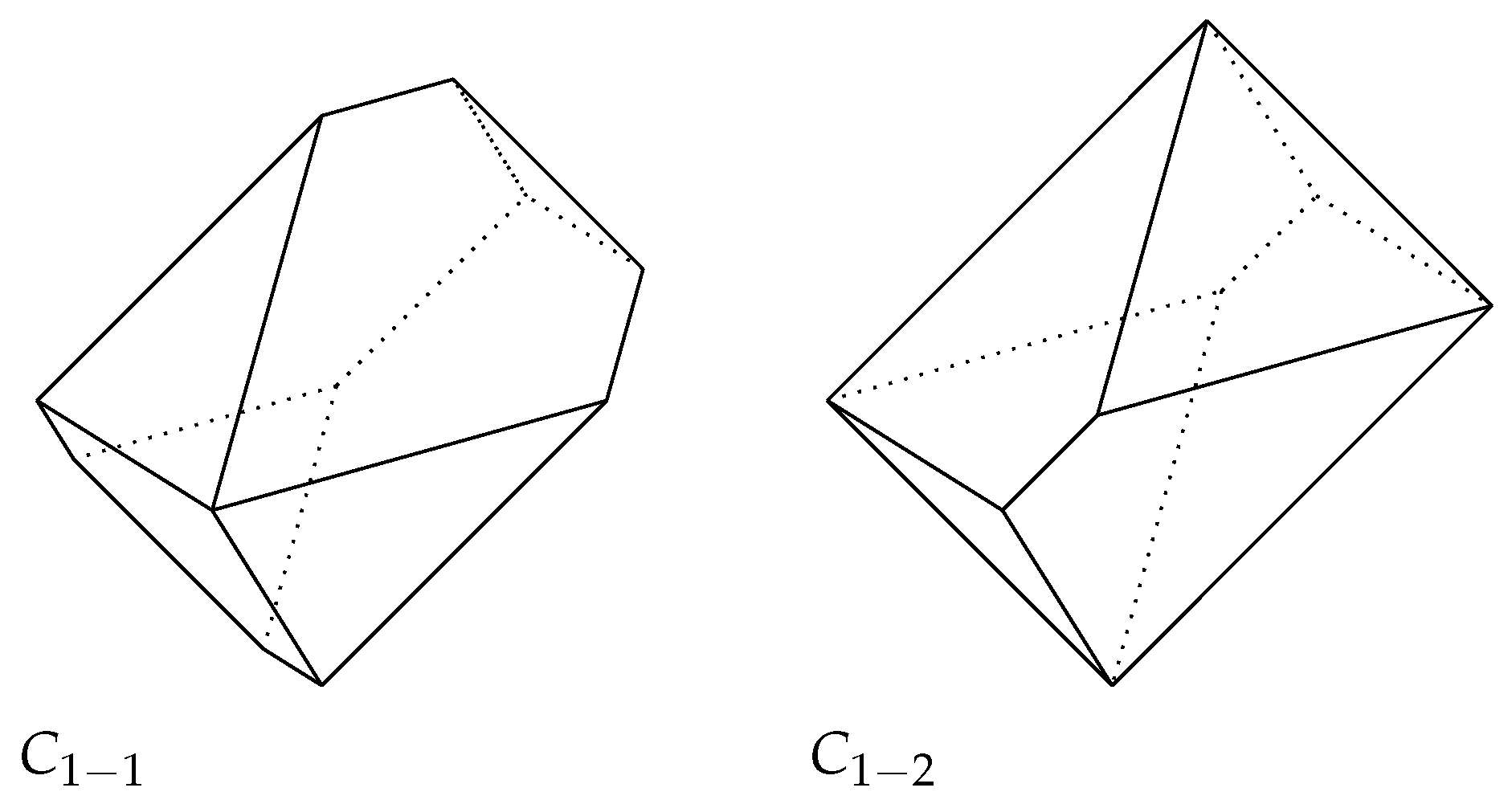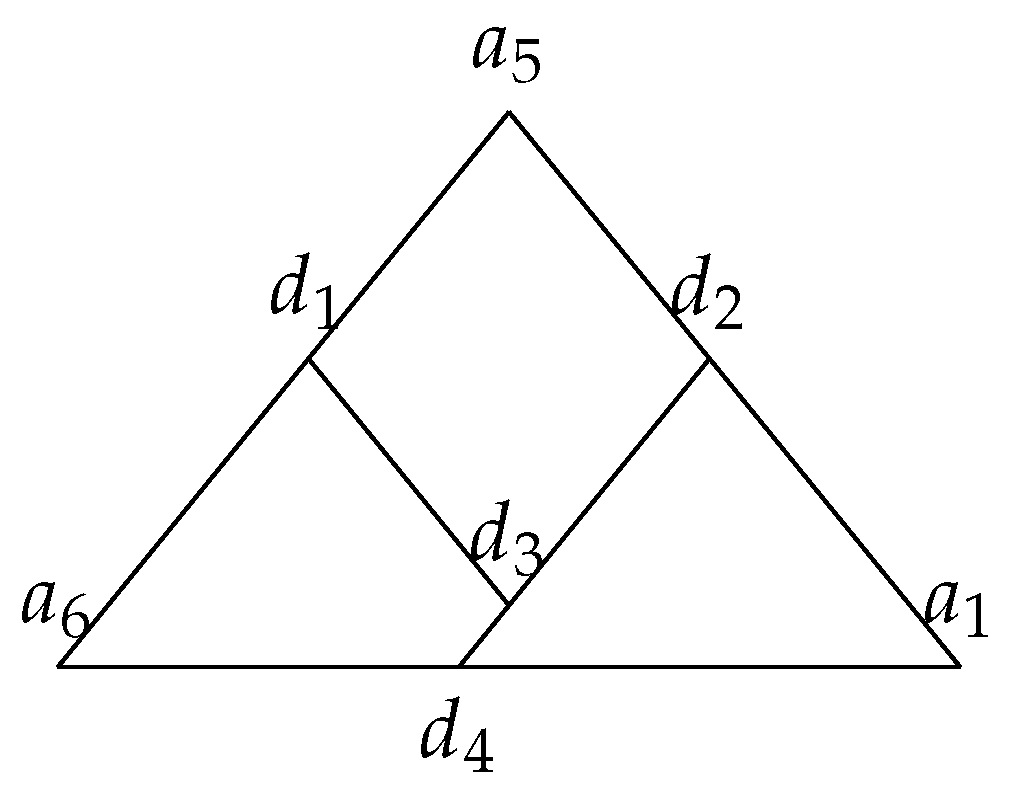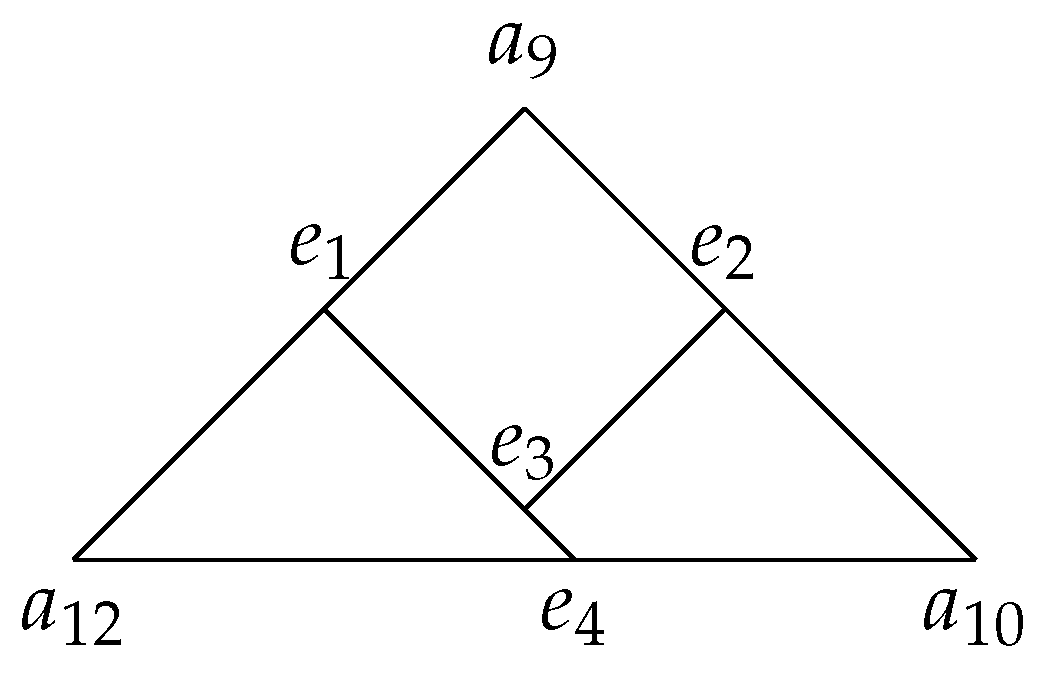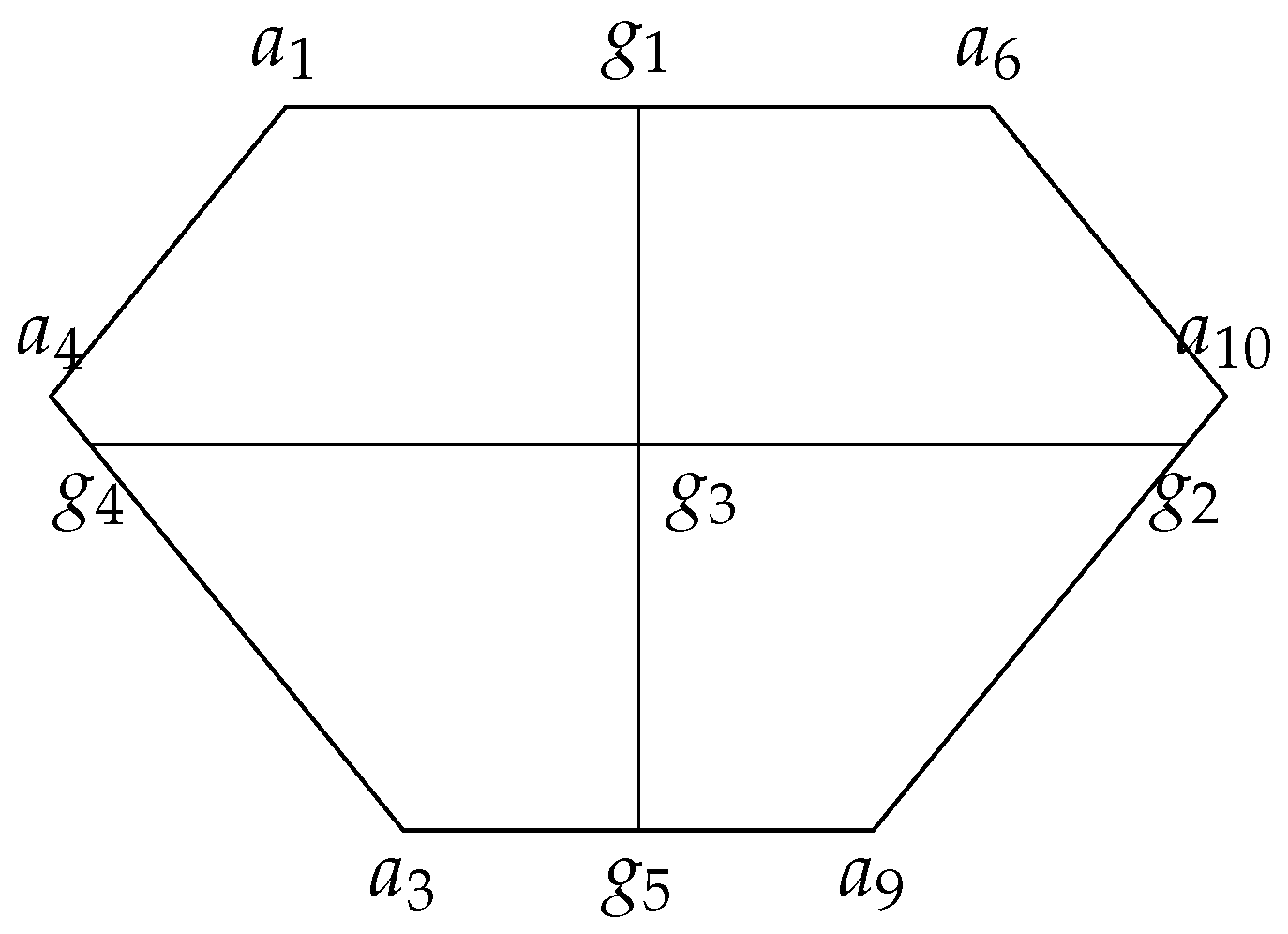Universal Covering System and Borsuk’s Problem in Finite Dimensional Banach Spaces
Abstract
1. Introduction
2. Universal Covering Systems
- 1.
- If, for each subset A of X with unit diameter, C contains an isometric copy of A, then C is called a universal cover (UC for short) in X (cf. [20]).
- 2.
- If, for each subset A of X with unit diameter, there exists a member of containing an isometric copy of A, then is called a universal covering system (UCS for short) in X.
- 1.
- Since every bounded set with unit diameter is contained in one of its completions, we may require further that each member of a UCS contains at least one complete set with unit diameter.
- 2.
- If is a UCS, , and A is an isometric copy of B, then is still a UCS.
- 1.
- We may assume that every UC under consideration is a convex body.
- 2.
- If a UCS is constructed starting from a UC which is a convex body (convex polytope, resp.) by repeatedly applying Theorem 1, then each member of the UCS is a convex body (convex polytope, resp.).
- 3.
- The construction described in Theorem 1 depends on the choice of x and y. In practice, we may assume that x and y are diametral.
| Algorithm 1 Partitioning of a UCS |
|
3. Borsuk’s Problem in
| Listing 1. Computing the vertices of and . |
| # Generate an octahedron with vertices (±1, 0, 0), (0, ±1, 0), and (0, 0, ±1). C0 = polytopes.cross_polytope(3) #H1: H1 = Polyhedron(ieqs=[(1/2, 1, −1, 1)]) #H2: H2 = Polyhedron(ieqs=[(1/2, −1, 1, −1)]) # Set C1 to be the intersection of C0 and H1. C1 = C0.intersection(H1) # Set C2 to be the intersection of C0 and H2. C2 = C0.intersection(H2) # Print the vertices of C1 and C2. print("Vertices of C1 are: {}. \nVertices of C2 are: {}".format(C1.vertices(), C2.vertices())) |
| Listing 2. Checking the containment. |
| # Check whether (−1/3, 1/3, 1/3) and (1/3, −1/3, −1/3) are both in C1. C1. contains ([−1/3, 1/3, 1/3]) and C1. contains ([1/3, −1/3, −1/3]) |
| Algorithm 2 Removing isometric copies from the members of a UCS |
|
4. An Estimation of
| Listing 3. Checking whether . |
| from sage.geometry.polyhedron.constructor import Polyhedron # The Vertex-representation of the polyhedron. polyhedron = Polyhedron(vertices=[(−3/8, −1/8, 0), (−3/8, 1/4, 3/8), (−1/8, −3/8, 0),(−1/8, −1/8, −1/4), (−1/8, 1/4, 5/8), (−1/8, 1/2, 3/8),(1/4, −3/8, 3/8), (1/4, −1/8, 5/8), (1/4, 1/4, −1/4),(1/4, 1/2, 0), (1/2, −1/8, 3/8), (1/2, 1/4, 0)]) # The Vertex-representation of the tetrahedron. tetrahedron = Polyhedron(vertices=[(−3/8, 1/2, 5/8), (1/2, −3/8, 5/8),(−3/8, −3/8, −1/4), (1/2, 1/2, −1/4)]) # Check whether all the vertices of the polyhedron are contained in the tetrahedron. print("The polyhedron is contained in the tetrahedron." if all(tetrahedron.contains(v) for v in polyhedron.vertices_list()) else "The polyhedron is not contained in the tetrahedron.") |
Author Contributions
Funding
Data Availability Statement
Conflicts of Interest
References
- He, C.; Martini, H.; Wu, S. Complete sets in normed linear spaces. Banach J. Math. Anal. 2023, 17, 45. [Google Scholar] [CrossRef]
- Borsuk, K. Drei Sätze über die n-dimensionale euklidische Sphäre. Fundam. Math. 1933, 20, 177–190. [Google Scholar]
- Eggleston, H.G. Covering a three-dimensional set with sets of smaller diameter. J. Lond. Math. Soc. 1955, 30, 11–24. [Google Scholar] [CrossRef]
- Grünbaum, B. A simple proof of Borsuk’s conjecture in three dimensions. Proc. Camb. Philos. Soc. 1957, 53, 776–778. [Google Scholar] [CrossRef]
- Heppes, A.; Révész, P. Zum Borsukschen Zerteilungsproblem. Acta Math. Acad. Sci. Hungar. 1956, 7, 159–162. [Google Scholar] [CrossRef]
- Heppes, A. On the partitioning of three-dimensional point-sets into sets of smaller diameter. Magyar Tud. Akad. Mat. Fiz. Oszt. Közl. 1957, 7, 413–416. [Google Scholar]
- Kahn, J.; Kalai, G. A counterexample to Borsuk’s conjecture. Bull. Am. Math. Soc. 1993, 29, 60–62. [Google Scholar]
- Hinrichs, A.; Richter, C. New sets with large Borsuk numbers. Discret. Math. 2003, 270, 137–147. [Google Scholar] [CrossRef]
- Bondarenko, A. On Borsuk’s conjecture for two-distance sets. Discret. Comput. Geom. 2014, 51, 509–515. [Google Scholar] [CrossRef]
- Jenrich, T.; Brouwer, A. A 64-dimensional counterexample to Borsuk’s conjecture. Electron. J. Comb. 2014, 21, 29. [Google Scholar]
- Zong, C. Borsuk’s partition conjecture. Jpn. J. Math. 2021, 16, 185–201. [Google Scholar] [CrossRef]
- Grünbaum, B. Borsuk’s partition conjecture in Minkowski planes. Bull. Res. Counc. Israel Sect. F 1957, 7, 25–30. [Google Scholar]
- Boltyanski, V.G.; Gohberg, I.T. Results and Problems in Combinatorial Geometry; Cambridge University Press: Cambridge, UK, 1985. [Google Scholar] [CrossRef]
- Boltyanski, V.; Martini, H.; Soltan, P.S. Excursions into Combinatorial Geometry; Universitext; Springer: Berlin/Heidelberg, Germany, 1997. [Google Scholar]
- Wang, J.; Xue, F. Borsuk’s partition problem in . Math. Inequal. Appl. 2023, 26, 131–139. [Google Scholar]
- Wang, J.; Xue, F.; Zong, C. On Boltyanski and Gohberg’s partition conjecture. Bull. Lond. Math. Soc. 2024, 56, 140–149. [Google Scholar] [CrossRef]
- Lian, Y.; Wu, S. Partition bounded sets into sets having smaller diameters. Results Math. 2021, 76, 116. [Google Scholar] [CrossRef]
- Zhang, L.; Meng, L.; Wu, S. Banach-Mazur distance from to . Math. Notes 2023, 114, 1045–1051. [Google Scholar] [CrossRef]
- Zhang, X.; He, C. Partitioning bounded sets in symmetric spaces into subsets with reduced diameter. Math. Inequalities Appl. 2024, 27, 703–713. [Google Scholar] [CrossRef]
- Martini, H.; Spirova, M.G. On universal covers in normed planes. Adv. Geom. 2013, 13, 41–50. [Google Scholar] [CrossRef]
- Tolmachev, A.D.; Protasov, D.S.; Voronov, V.A. Coverings of planar and three-dimensional sets with subsets of smaller diameter. Discret. Appl. Math. 2022, 320, 270–281. [Google Scholar] [CrossRef]
- Han, X.; Wu, S.; Zhang, L. An algorithm based on compute unified device architecture for estimating covering functionals of convex bodies. Axioms 2024, 2, 132. [Google Scholar] [CrossRef]
- Yu, M.; Lyu, Y.; Zhao, Y.; He, C.; Wu, S. Estimations of covering functionals of convex bodies based on relaxation algorithm. Mathematics 2023, 11, 2000. [Google Scholar] [CrossRef]
- He, C.; Lyu, Y.; Martini, H.; Wu, S. A branch-and-bound approach for estimating covering functionals of convex bodies. J. Optim. Theory Appl. 2023, 196, 1036–1055. [Google Scholar] [CrossRef]
- Qi, X.; Zhang, X.; Lyu, Y.; Wu, S. The Algorithm for Generating UCS. Available online: https://github.com/Qi-XC/Universal-covering-system-and-Borsuk-s-problem-in-finite-dimensional-Banach-spaces.git, (accessed on 12 March 2025).
- Zong, C. A quantitative program for Hadwiger’s covering conjecture. Sci. China Math. 2010, 53, 2551–2560. [Google Scholar] [CrossRef]










Disclaimer/Publisher’s Note: The statements, opinions and data contained in all publications are solely those of the individual author(s) and contributor(s) and not of MDPI and/or the editor(s). MDPI and/or the editor(s) disclaim responsibility for any injury to people or property resulting from any ideas, methods, instructions or products referred to in the content. |
© 2025 by the authors. Licensee MDPI, Basel, Switzerland. This article is an open access article distributed under the terms and conditions of the Creative Commons Attribution (CC BY) license (https://creativecommons.org/licenses/by/4.0/).
Share and Cite
Qi, X.; Zhang, X.; Lyu, Y.; Wu, S. Universal Covering System and Borsuk’s Problem in Finite Dimensional Banach Spaces. Axioms 2025, 14, 277. https://doi.org/10.3390/axioms14040277
Qi X, Zhang X, Lyu Y, Wu S. Universal Covering System and Borsuk’s Problem in Finite Dimensional Banach Spaces. Axioms. 2025; 14(4):277. https://doi.org/10.3390/axioms14040277
Chicago/Turabian StyleQi, Xincong, Xinling Zhang, Yunfang Lyu, and Senlin Wu. 2025. "Universal Covering System and Borsuk’s Problem in Finite Dimensional Banach Spaces" Axioms 14, no. 4: 277. https://doi.org/10.3390/axioms14040277
APA StyleQi, X., Zhang, X., Lyu, Y., & Wu, S. (2025). Universal Covering System and Borsuk’s Problem in Finite Dimensional Banach Spaces. Axioms, 14(4), 277. https://doi.org/10.3390/axioms14040277







